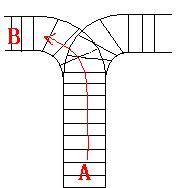Train Problem I
Time Limit: 2000/1000 MS (Java/Others) Memory Limit: 65536/32768 K (Java/Others)
Total Submission(s): 25817 Accepted Submission(s): 9752
Problem Description
As the new term comes, the Ignatius Train Station is very busy nowadays. A lot of student want to get back to school by train(because the trains in the Ignatius Train Station is the fastest all over the world ^v^). But here comes a problem, there is only one railway where all the trains stop. So all the trains come in from one side and get out from the other side. For this problem, if train A gets into the railway first, and then train B gets into the railway before train A leaves, train A can't leave until train B leaves. The pictures below figure out the problem. Now the problem for you is, there are at most 9 trains in the station, all the trains has an ID(numbered from 1 to n), the trains get into the railway in an order O1, your task is to determine whether the trains can get out in an order O2.



Input
The input contains several test cases. Each test case consists of an integer, the number of trains, and two strings, the order of the trains come in:O1, and the order of the trains leave:O2. The input is terminated by the end of file. More details in the Sample Input.
Output
The output contains a string "No." if you can't exchange O2 to O1, or you should output a line contains "Yes.", and then output your way in exchanging the order(you should output "in" for a train getting into the railway, and "out" for a train getting out of the railway). Print a line contains "FINISH" after each test case. More details in the Sample Output.
Sample Input
3 123 321
3 123 312
Sample Output
Yes.
in
in
in
out
out o
ut
FINISH
No.
FINISH
Hint
Hint这个题意说简单形象点就是火车进站,只有一条路,先进站的后出站,输入的前面字符串时进站的顺序,后面是出站的顺序,问是否可按后面顺序出来!
显然这是一个典型的栈的问题!
1 #include<stdio.h> 2 #include<string.h> 3 #include<stack> 4 using namespace std; 5 char a[10],b[10]; 6 int c[20]; 7 int main() 8 { 9 int n,i,j,k; 10 stack<char>s;//初始化一个栈 11 while(scanf("%d",&n)!=EOF) 12 { 13 getchar(); 14 scanf("%s%s",a,b); 15 memset(c,-1,sizeof(c)); 16 while(!s.empty()) 17 s.pop(); 18 i=j=k=0; 19 while(i<n) 20 { 21 s.push(a[i++]); 22 c[j++]=1; 23 while(!s.empty()&&s.top()==b[k])//为什么要判断是否为空栈?这个是为了跳出while循环,如果是空栈了。就没栈顶了,没比较的意义了! 24 { 25 k++; 26 c[j++]=0; 27 s.pop();//消栈 28 } 29 } 30 if(!s.empty()) 31 { 32 printf("No. ");//如果栈不为空,就是没消完 33 printf("FINISH "); 34 35 } 36 else 37 { 38 printf("Yes. "); 39 for(i=0;i<j;i++) 40 { 41 if(c[i]==1) 42 printf("in "); 43 else if(c[i]==0) 44 printf("out "); 45 46 } 47 printf("FINISH "); 48 } 49 } 50 return 0; 51 }